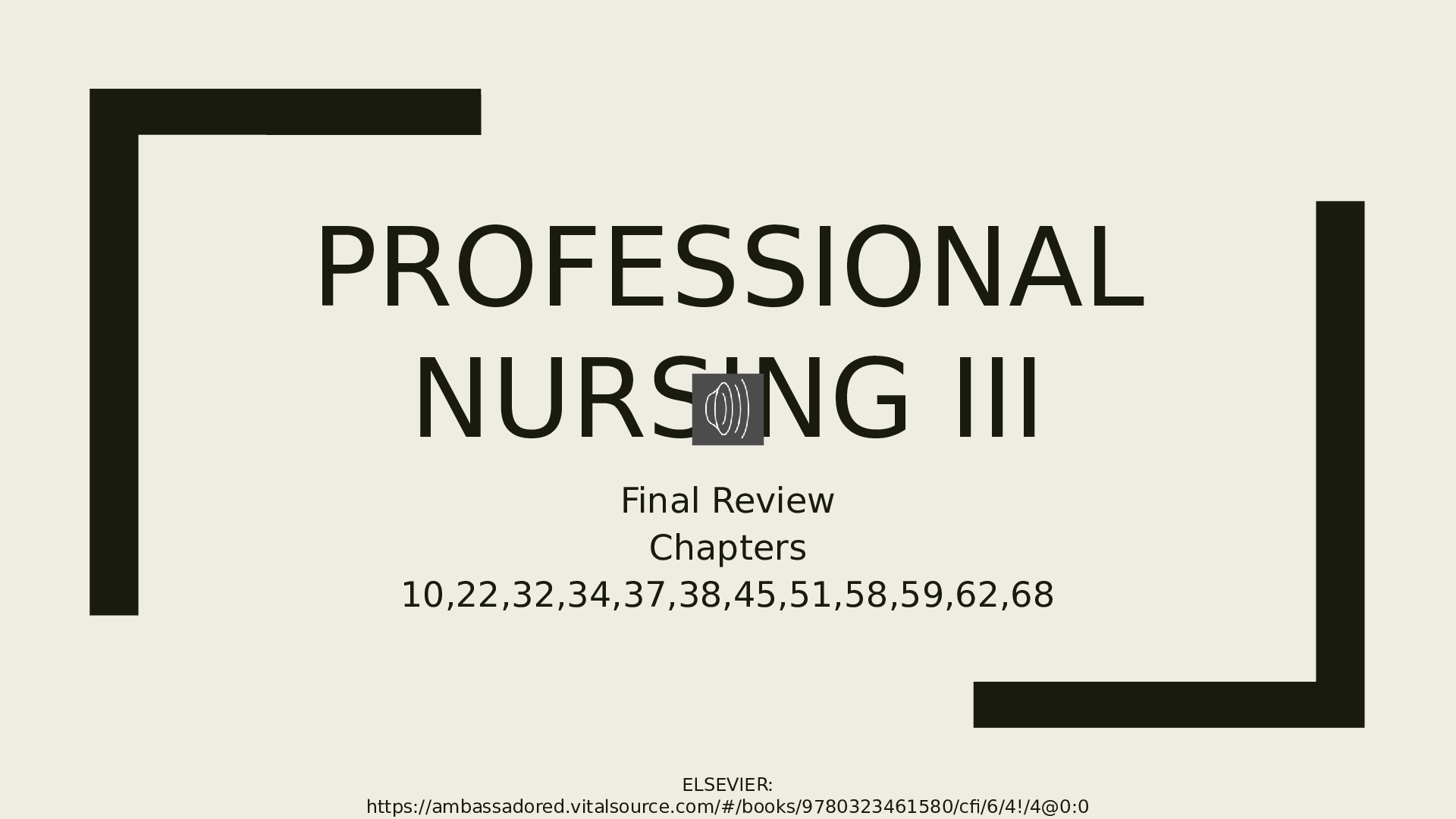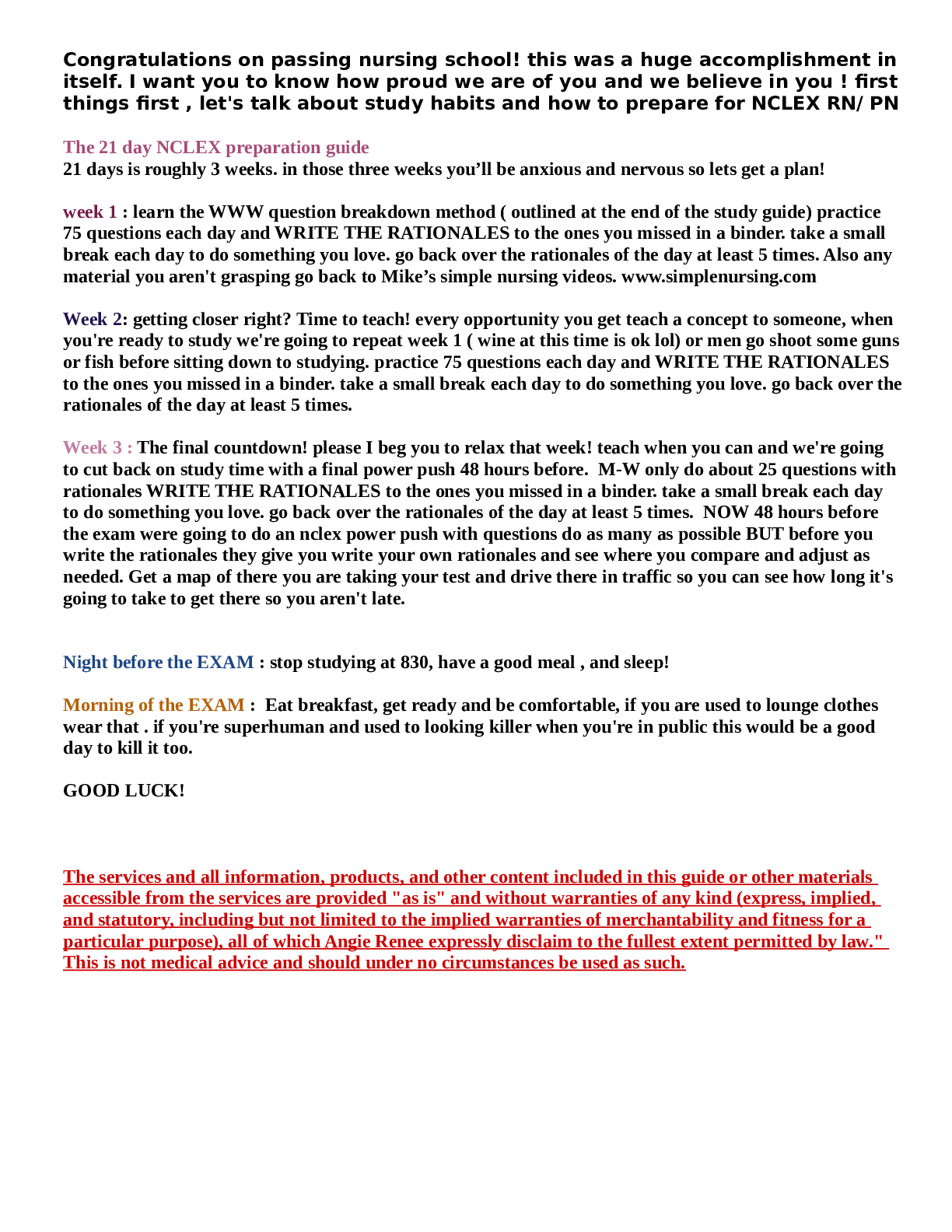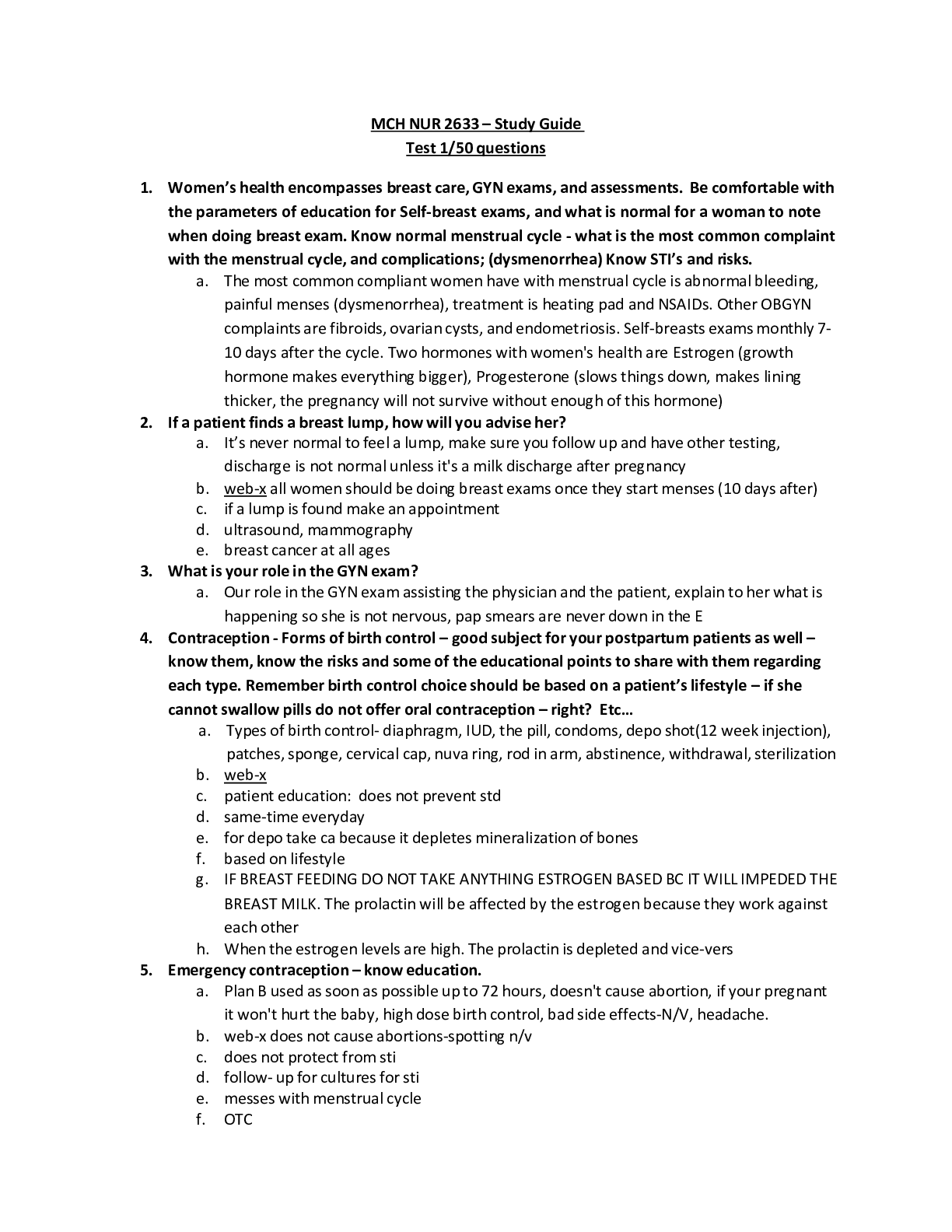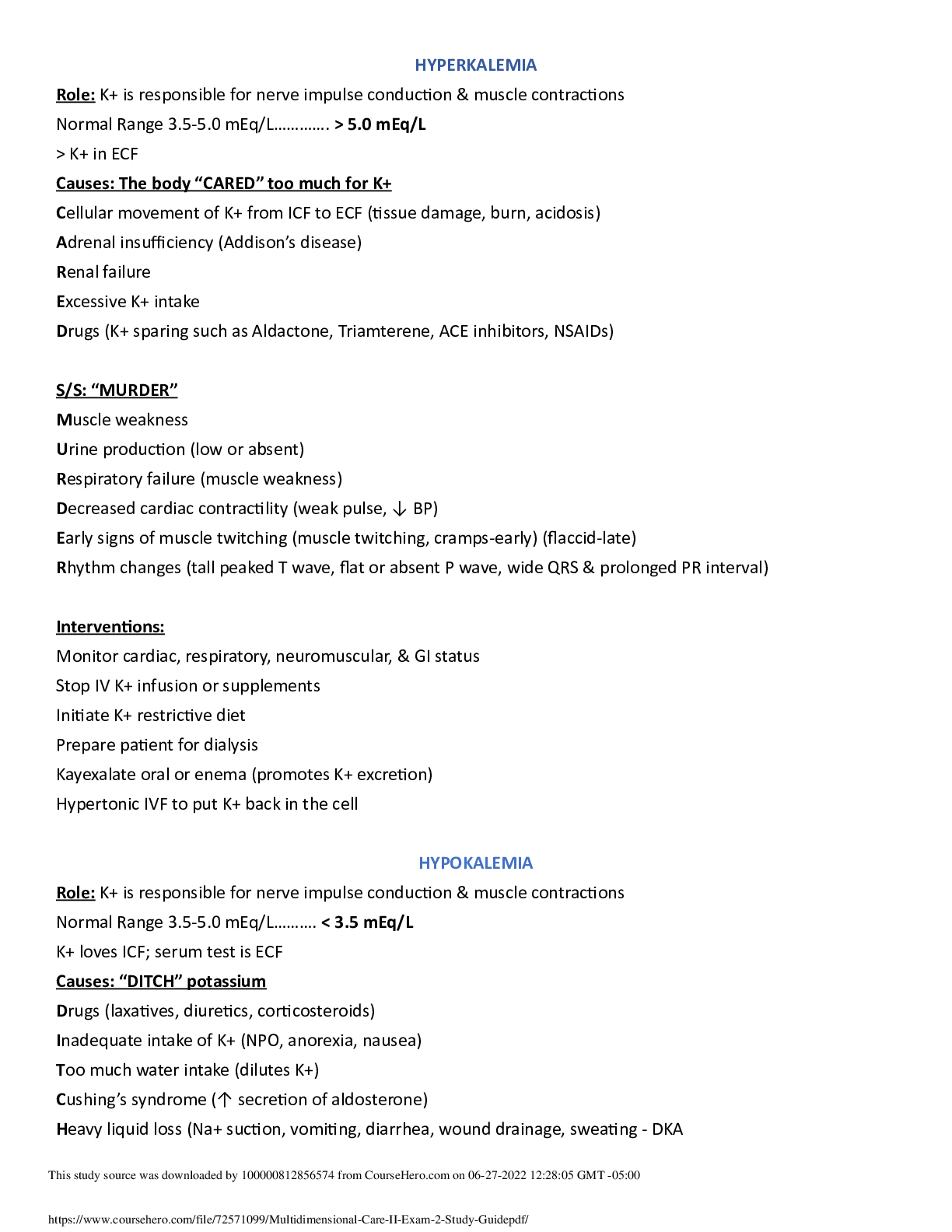*NURSING > STUDY GUIDE > Rasmussen College PN 3PN3 final review-REVIEWED AND VERIFIED BY EXPERTS-LATEST EDITION (All)
Rasmussen College PN 3PN3 final review-REVIEWED AND VERIFIED BY EXPERTS-LATEST EDITION
Document Content and Description Below
PROFESSIONAL NURSING III Final Review Chapters 10,22,32,34,37,38,45,51,58,59,62,68 ELSEVIER: https://ambassadored.vitalsource.com/#/books/9780323461580/cfi/6/4!/4@0:0Care of Patients with Cancer... CH 22 ■ Patient education associated with chemotherapy induced thrombocytopenia – Bone Marrow Suppression – In addition to killing cancer cells, chemotherapy also destroys circulating blood cells and further reduces IMMUNITY by suppressing bone marrow replacement of these cells. The numbers of all circulating leukocytes, erythrocytes, and platelets are decreased. Reduced leukocyte numbers, especially neutrophils, greatly increase the risk for infection. Decreased erythrocytes and platelets cause hypoxia, fatigue, and impaired CLOTTING, leading to increased bleeding. – A normal platelet count ranges from 150,000 to 450,000 platelets per microliter of blood. Having more than 450,000 platelets is a condition called thrombocytosis; having less than 150,000 is known as thrombocytopenia ■ Chart 22-6 Patient and Family Education: Preparing for Self-Management Preventing Injury or Bleeding During the time platelet count is low: – • Use an electric shaver. – • Use a soft-bristled toothbrush. – • Do not have dental work performed without consulting your cancer health care provider. – • Do not take aspirin or any aspirin-containing products. Read the label to be sure that the product does not contain aspirin or salicylates. – • Do not participate in contact sports or any activity likely to result in your being bumped, scratched, or scraped. – • If you are bumped, apply ice to the site for at least 1 hour. ■ If you bump your head, go to the ER for a CT. – • Avoid hard foods that would scrape the inside of your mouth. – • Eat only warm, cool, or cold foods to avoid burning your mouth. Be especially cautious with cheese topping on pizza. – • Check your skin and mouth daily for bruises; swelling; or areas with small, reddish-purple marks that may indicate bleeding. – • Notify your cancer health care provider if you: ■ • Are injured and persistent bleeding results ■ • Have menstrual bleeding that is excessive for you ■ • See blood in your vomit, urine, or bowel movement • Avoid trauma with intercourse. • Avoid anal intercourse. • Take a stool softener to prevent straining during a bowel movement. • Do not use enemas or rectal suppositories. • Avoid bending over at the waist, which increases pressure in the brain. • Do not wear clothing or shoes that are tight or that rub. • Avoid blowing your nose or placing objects in your nose. If you must blow your nose, do so gently without blocking either nasal passage. ■ Recognize precautions with internal radiation (brachytherapy) - The energy produced by radioactive elements (gamma rays, alpha particles, beta particles) varies in its ability to penetrate tissues and damage cells (Fig. 22-1). Gamma rays are used most commonly for radiation therapy because of their ability to deeply penetrate tissues. Beta particles are weaker and must be placed within or very close to the cancer cells for cancer therapy (see discussion of brachytherapy in the Radiation Delivery Methods and Devices section). – Brachytherapy, also known as internal radiotherapy, means “short” (close) therapy. The radiation source comes into direct, continuous contact with the tumor for a specific time period. This method provides a higher dose of radiation in the tumor over a specified time period, limiting the dose in surrounding normal tissues. – Nursing Safety Priority Action Alert: Unsealed isotopes enter body fluids and eventually are eliminated in waste products. These wastes are radioactive, and you must ensure that they are not directly touched by anyone. Handle the wastes according to guidelines established by the institution. During hospitalization for high-dose rate implant radiation, pregnant women and children are not allowed to visit the patient. After the isotope is completely eliminated from the body, neither the patient nor the body wastes are radioactive. ■ Chart 22-1 Best Practice for Patient Safety & Quality Care Care of the Patient With Sealed Implants of Radioactive Sources – Assign the patient to a private room with a private bath. – • Place a “Caution: Radioactive Material” sign on the door of the patient's room. – • If portable lead shields are used, place them between the patient and the door. – • Keep the door to the patient's room closed as much as possible. – • Wear a dosimeter film badge at all times while caring for patients with radioactive implants. The badge offers no protection but measures a person's exposure to radiation. Each person caring for the patient should have a separate dosimeter to calculate his or her specific radiation exposure. – • Wear a lead apron while providing care. Always keep the front of the apron facing the source of radiation (do not turn your back toward the patient). – • If you are attempting to conceive, do not perform direct patient care, regardless of whether you are male or female. – • Pregnant nurses should not care for these patients; do not allow pregnant women or children younger than 16 years to visit. – • Limit each visitor to one-half hour per day. Be sure visitors stay at least 6 feet from the source. – • Never touch the radioactive source with bare hands. In the rare instance that it is dislodged, use a long-handled forceps to retrieve it. Deposit the radioactive source in the lead container kept in the patient's room. – • Save all dressings and bed linens in the patient's room until after the radioactive source is removed. After the source is removed, dispose of dressings and linens in the usual manner. Other equipment can be removed from the room at any time without special precautions and does not pose a hazard to other people. ELSEVIER: https://ambassadored.vitalsource.com/#/books/9780323461580/cfi/6/4!/4@0:0Care of Patients with Cancer CH 22 ■ Management of chemotherapy induced anemia (Hgb male 14-18 g/dL, female 12-16 g/dL) – Serious short-term side effects occur with cytotoxic chemotherapy. – The side effects on the hematopoietic (blood-producing) system can be life threatening and are the most common reason for changing the dosage or the treatment plan. – The suppressive effects on the bone marrow blood-forming cells cause anemia (decreased numbers of red blood cells and hemoglobin); reduced IMMUNITY with neutropenia (decreased numbers of neutrophil white blood cells leading to immunosuppression); and thrombocytopenia (decreased numbers of platelets), which leads to impaired CLOTTING and bleeding. – Erythropoiesis-stimulating agents (ESAs) such as darbepoetin alfa (Aranesp) and epoetin alfa (Epogen and Procrit) can prevent or improve – Common distressing side effects include nausea and vomiting, alopecia (hair loss), mucositis (open sores on mucous membranes), many skin changes, anxiety, sleep disturbance, altered bowel elimination, and changes in cognitive function. – The impact of these side effects is referred to as cancer therapy symptom distress, which can vary from patient to patient. – Older adults are at even greater risk for chemotherapy-induced neutropenia because of agerelated changes in bone marrow function (McCance et al., 2014). – When do we transfuse/treat low Hgb?? Hgb <8, often depends on facility and pt (symptoms?? [Show More]
Last updated: 2 years ago
Preview 1 out of 63 pages

Buy this document to get the full access instantly
Instant Download Access after purchase
Buy NowInstant download
We Accept:

Reviews( 0 )
$15.00
Can't find what you want? Try our AI powered Search
Document information
Connected school, study & course
About the document
Uploaded On
May 17, 2021
Number of pages
63
Written in
Additional information
This document has been written for:
Uploaded
May 17, 2021
Downloads
0
Views
126
















